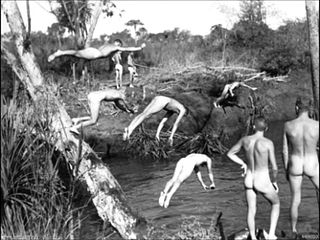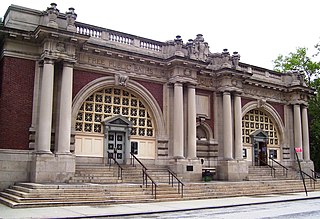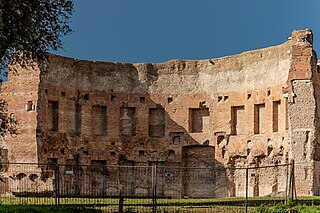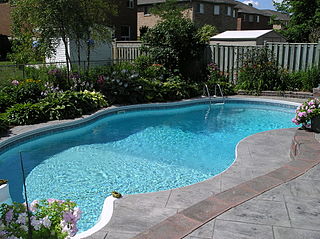Related Research Articles

A sauna, or sudatory, is a small room or building designed as a place to experience dry or wet heat sessions, or an establishment with one or more of these facilities. The steam and high heat make the bathers perspire. A thermometer in a sauna is typically used to measure temperature; a hygrometer can be used to measure levels of humidity or steam. Infrared therapy is often referred to as a type of sauna, but according to the Finnish sauna organisations, infrared is not a sauna.

A swimsuit is an item of clothing designed to be worn by people engaging in a water-based activity or water sports, such as swimming, diving and surfing, or sun-orientated activities, such as sun bathing. Different types may be worn by men, women, and children. A swimsuit can be described by various names, some of which are used only in particular locations, including swimwear, bathing suit, swimming costume, bathing costume, swimming suit, swimmers, swimming togs, bathers, cossie, or swimming trunks for men, besides others.

The bathing machine was a device, popular from the 18th century until the early 20th century, to allow people to change out of their usual clothes, change into swimwear, and wade in the ocean at beaches. Bathing machines were roofed and walled wooden carts rolled into the sea. Some had solid wooden walls, others canvas walls over a wooden frame, and commonly walls at the sides and curtained doors at each end.

Bathing is the act of washing the body, usually with water, or the immersion of the body in water. It may be practiced for personal hygiene, religious ritual or therapeutic purposes. By analogy, especially as a recreational activity, the term is also applied to sun bathing and sea bathing.

Nude swimming is the practice of swimming without clothing, whether in natural bodies of water or in swimming pools. A colloquial term for nude swimming is skinny-dipping.

Public baths originated when most people in population centers did not have access to private bathing facilities. Though termed "public", they have often been restricted according to gender, religious affiliation, personal membership, and other criteria. In addition to their hygienic function, public baths have also been social meeting places. They have included saunas, massages, and other relaxation therapies, as are found in modern day spas. As the percentage of dwellings containing private bathrooms has increased in some societies, the need for public baths has diminished, and they are now almost exclusively used recreationally.

A spa is a location where mineral-rich spring water is used to give medicinal baths. Spa towns or spa resorts typically offer various health treatments, which are also known as balneotherapy. The belief in the curative powers of mineral waters goes back to prehistoric times. Such practices have been popular worldwide, but are especially widespread in Europe and Japan. Day spas and medspas are also quite popular, and offer various personal care treatments.

A hot tub is a large tub full of water used for hydrotherapy, relaxation or pleasure. Some have powerful jets for massage purposes. Hot tubs are sometimes also known as "spas" or by the trade name Jacuzzi.

Sea bathing is swimming in the sea or in sea water and a sea bath is a protective enclosure for sea bathing. Unlike bathing in a swimming pool, which is generally done for pleasure or exercise purposes, sea bathing was once thought to have curative or therapeutic value. It arose from the medieval practice of visiting spas for the beneficial effects of the waters. The practice of sea bathing dates back to the 17th century but became popular in the late 18th century. The development of the first swimsuits dates from the period as does the development of the bathing machine.

The Széchenyi Medicinal Bath in Budapest is the largest medicinal bath in Budapest. Its water is supplied by two thermal springs, their temperature is 74 °C (165 °F) and 77 °C (171 °F).

A banya is originally a Russian steam bath with a wood stove. It is considered an important part of Russian culture. The bath takes place in a small room or building designed for dry or wet heat sessions. The steam and high heat make the bathers perspire. Genders were traditionally segregated in the banya, with separate rooms for the sexes.

A frigidarium is one of the three main bath chambers of a Roman bath or thermae, namely the cold room. It often contains a swimming pool.

An automated pool cleaner is a vacuum cleaner that is designed to collect debris and sediment from swimming pools with minimal human intervention.

The Baths of Agrippa was a structure of ancient Rome, in what is now Italy, built by Marcus Vipsanius Agrippa. It was the first of the great thermae constructed in the city, and also the first public bath.

Bathing played a major part in ancient Roman culture and society. It was one of the most common daily activities and was practiced across a wide variety of social classes. Though many contemporary cultures see bathing as a very private activity conducted in the home, bathing in Rome was a communal activity. While the extremely wealthy could afford bathing facilities in their homes, private baths were very uncommon, and most people bathed in the communal baths (thermae). In some ways, these resembled modern-day destination spas as there were facilities for a variety of activities from exercising to sunbathing to swimming and massage.
Swimming pool sanitation is the process of ensuring healthy conditions in swimming pools. Proper sanitation is needed to maintain the visual clarity of water and to prevent the transmission of infectious waterborne diseases.

A swimming pool service technician, known colloquially as a pool cleaner, is a tradesperson who cleans swimming pools and services major pool equipment such as pumps, motors, and filters.
Designated as an American National Standard, the Uniform Swimming Pool, Spa and Hot Tub Code (USPSHTC) is a model code developed by the International Association of Plumbing and Mechanical Officials (IAPMO) to govern the installation and inspection of plumbing systems associated with swimming pools, spas and hot tubs as a means of promoting the public's health, safety and welfare.

A swimming pool, swimming bath, wading pool, paddling pool, or simply pool, is a structure designed to hold water to enable swimming or other leisure activities. Pools can be built into the ground or built above ground, and may be found as a feature aboard ocean-liners and cruise ships. In-ground pools are most commonly constructed from materials such as concrete, natural stone, metal, plastic, or fiberglass, and can be of a custom size and shape or built to a standardized size, the largest of which is the Olympic-size swimming pool.

Greek baths were bath complexes suitable for bathing and cleaning in ancient Greece, similar in concept to that of the Roman baths. Greek baths are a feature of some Hellenized countries. These baths have been found in Greece, Egypt, Italy, and there is even one located in Marseille, France. Some of the first baths have been dated back to the 5th century BCE. The public baths had a gradual development into the flourishing, culturally-significant structures of the Hellenistic age. The multiple locations of the baths throughout the Mediterranean offer different, culturally-unique developments.
References
- ↑ "Hot Tub Spa & Pool Glossary". Archived from the original on 14 April 2009. Retrieved 2009-04-16.
- ↑ Shaw, Ron; CLP, and Dave Arnolde (July–August 1993). "The Pools Factor: Does Your Community Have Enough Space?" . Retrieved 2009-04-16.